Headache Locations
A headache is defined as pain occurring in a specific area of the head or upper neck. In reality, the brain itself is not sensitive to pain. Structures in the head that are sensitive to pain include: cranial nerves, arteries and veins, scalp and neck muscles, skin, superficial nerves, sinuses, the external auditory canal and eardrum, the eyeball and surrounding structures, salivary glands, teeth, jaw joint (TMJ), and the carotid artery and its branches.
Headaches can be dull, sharp, throbbing, constant, intermittent, mild, or severe. Headache is a common complaint in society, and about 70% of people who experience it have recurring headaches. Although headaches can negatively impact quality of life, they are usually not life-threatening. However, in the following cases, medical attention should be sought immediately:
If the pain starts suddenly and is the most intense headache you’ve ever experienced
If the headache does not subside and intensifies
If it causes double or blurred vision
If accompanied by nausea or vomiting
If it begins after the age of 50
If it develops after a head injury or accident
If it presents with neck stiffness or fever
Causes of Headache
The pain we perceive comes from stimulation of the meninges (brain membranes), blood vessels, and nerves. Especially, blood vessels and head muscles send pain signals to the brain, though exactly how these signals start is still unclear.
Common causes of headache include:
Illness: Infections (such as colds and fevers), sinusitis (inflammation of the sinuses), throat or ear infections can all trigger headaches. In some cases, headache can be a symptom of more serious conditions like brain tumors or cerebral hemorrhage.
Stress: In addition to stress and depression, excessive alcohol intake, skipping meals, changes in sleep patterns, and overuse of medication are all contributing factors.
Environmental and chemical triggers: Exposure to cigarette smoke, household chemicals, perfumes, allergens, and certain food odors can also lead to headaches. Environmental pollution, loud noise, and sudden weather changes are additional triggers.
Genetic factors: Primary headaches such as migraine have a genetic component. If someone in the family has migraines, the likelihood of developing it is about 40%. If both parents suffer from migraine, the risk increases to around 75%. Most children and teenagers with migraines have a family history of the condition.
Causes of Headache
The pain we feel is a complex stimulus arising from the meninges, blood vessels, and nerves. In particular, the blood vessels and head muscles send pain signals to the brain, although exactly how these signals are triggered is not fully understood.
Common causes of headaches include:
Illnesses: Many conditions such as infections (common cold and high fever), sinusitis (inflammation of the sinuses), throat infections, or ear infections can cause headaches. Headaches can also be symptoms of more serious conditions like brain tumors or cerebral hemorrhage.
Stress: Stress and depression, excessive alcohol consumption, skipping meals, disruptions in sleep patterns, and overuse of medication can all contribute to headaches.
Tobacco smoke and environmental-chemical factors: Exposure to cigarette smoke, household chemicals, perfumes, allergens, and food odors can also trigger headaches. Sudden weather changes, noise, and air pollution are additional factors.
Genetic factors: Migraines, a type of primary headache, are known to have genetic components. If a family member has migraines, the likelihood of developing them is about 40%. If both parents suffer from migraines, the risk can increase to 75%. Most children and adolescents with migraines have other migraine sufferers in their family.
Types of Headaches
In 2018, the International Headache Society published the latest classification system for headaches. The characteristics of a headache are crucial for identifying its cause and selecting the appropriate treatment. For this reason, patients should clearly describe the nature, frequency, and accompanying symptoms of their headaches.
Based on the source of the pain, the International Headache Society categorizes headaches into three main types:
Primary headaches
Secondary headaches
Cranial neuralgia, facial pain, and other headaches
What is a Primary Headache?
Among primary headaches, the most common types are migraine, tension-type (tonic), and cluster (circular) headaches.
Tension-Type Headaches
Tension-type headaches are the most common form of primary headaches. They are more frequently seen in women than in men. According to the World Health Organization, 1 in every 20 people experiences daily tension-type headaches.
These headaches are divided into two categories: episodic and chronic.
Episodic tension headaches last from 30 minutes to 7 days, affect both sides of the head, and cause a pressing or tightening pain. The pain may spread to the forehead and neck and is usually not severe
Main symptoms of tension-type (tonic) headaches include:
Pain originates from muscle tension around the head and is typically felt across the whole head.
The pain feels like pressure, tightness, or heaviness.
It may last for just 5–10 minutes or continue non-stop for days.
Nausea, vomiting, and sensitivity to light/sound are rare.
The pain usually starts in the afternoon and may interfere with sleep.
Psychological stress, anxiety, depression, and muscle tension (such as prolonged driving or poor posture) are common triggers.
Overuse of painkillers can worsen tension-type headaches.
These headaches are not worsened by physical activity and rarely cause nausea. Sensitivity to light or sound may occur but is uncommon.
In chronic cases, the patient experiences headaches at least 15 times per month for a minimum of 6 months per year.
Main symptoms of tension-type (tonic) headaches include:
Pain originates from muscle tension around the head and is typically felt across the whole head.
The pain feels like pressure, tightness, or heaviness.
It may last for just 5–10 minutes or continue non-stop for days.
Nausea, vomiting, and sensitivity to light/sound are rare.
The pain usually starts in the afternoon and may interfere with sleep.
Psychological stress, anxiety, depression, and muscle tension (such as prolonged driving or poor posture) are common triggers.
Overuse of painkillers can worsen tension-type headaches
Migraine Headache
Migraine is the second most common type of primary headache. Migraine-related headaches affect not only adults but also children. Before puberty, migraine affects boys and girls equally; however, after puberty, women are more likely than men to suffer from migraine headaches. In general, many individuals with migraine have a family history of the condition.
Certain foods and drinks can trigger migraines, including aged cheese, chocolate, yogurt, onions, figs, liver, caffeinated foods and beverages, and smoked or salty fish/meat. Irregular sleep (too much or too little), hunger, physical or mental fatigue, and shift work are also contributing factors. Additionally, hormonal changes during menstruation, changes in weather or atmospheric pressure, flickering or bright lights, strong odors (perfume, chemicals, cigarette smoke), and stress are other common triggers.
Characteristics of Migraine Headaches:
They occur in episodes (no headache between attacks)
If untreated, headaches may last between 4 and 72 hours
Pain is typically one-sided
The pain is pulsating and intense
May be accompanied by nausea and/or vomiting
Sensitivity to light and sound is common
Visual disturbances such as flashing lights or zigzag lines may appear before the headache start
Cluster Headache
Cluster headache is a rare type of primary headache. It affects mostly men between the ages of 20 and 30, though women and children can also suffer from this type.
Characteristics of Cluster Headaches:
More common in men than women
What Is a Secondary Headache?
A secondary headache is a symptom of another condition that activates pain-sensitive structures in the head. These headaches can be caused by local or systemic illnesses. Causes of secondary headaches range from dental or sinus infections to life-threatening conditions such as brain hemorrhage, encephalitis, or meningitis. Additional causes include trauma-related headaches, headaches after a concussion, substance abuse, overuse of headache medications, and excessive alcohol consumption.
Some causes of secondary headaches include:
Medication-related headaches: Many drugs list headache as a side effect. Ironically, overuse of medications intended to treat headaches can cause more frequent headaches, especially in migraine sufferers.
Brain tumor or aneurysm: May present with headaches, vision problems, personality changes, or ear ringing. These symptoms require urgent medical attention.
Spinal headaches: Caused by low cerebrospinal fluid pressure or volume, sometimes after spinal anesthesia or a lumbar puncture.
Sinus headaches: Acute sinusitis causes pain in the forehead, nose, around the eyes, cheeks, or upper teeth. Pain worsens when bending over. Nasal congestion and fever are common symptoms.
Post-traumatic headaches: These can occur after a fall, car accident, or any head injury.
High blood pressure: Uncontrolled hypertension can cause pain in the forehead or neck, sometimes accompanied by nosebleeds.
Eye pressure: Acute angle-closure glaucoma causes intense headache, typically in the evening, and may include blurry vision and nausea.
Hormonal headaches: Often linked to fluctuations in estrogen levels, such as during menstruation, pregnancy, or while taking birth control pills. These are known as menstrual migraines.
Other potential causes include carotid or vertebral artery dissection, cerebral venous thrombosis, brain aneurysm, carbon monoxide poisoning, COVID-19, dehydration, intracranial hematoma, meningitis, panic attacks, and toxoplasmosis.
Severe, pulsating pain around one eye that can last from 15 minutes to 3 hours and may recur several times a day
May be accompanied by redness of the eye, tearing, eyelid drooping, nasal congestion, or runny nose
Often occurs during specific seasons of the year

